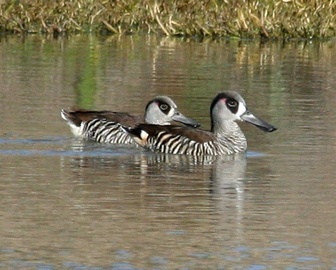Pink-eared Duck
It is the only living member of the genus Malacorhynchus; a closely related, but slightly larger extinct form from New Zealand was described as Scarlett's Duck . This peculiar duck may be most closely related to the shelducks but its relationships are enigmatic. It may be closer to the Musk Duck and the stiff-tails and, formerly placed in the paraphyletic perching ducks it is in any case not close to the dabbling ducks.

Original source: http://en.wikipedia.org/wiki/Image:Pink_eared_duck.jpg
Author: Jason GirvanPermission(Reusing this file)GFDL
Permission: GNU Free Documentation License
The Pink-eared Duck is classified as Least Concern. Does not qualify for a more at risk category. Widespread and abundant taxa are included in this category.
The Pink-eared Duck (Malacorhynchus membranaceus) is a species of duck found in Australia. It has a large spatulate bill like the Australasian Shoveler, but is smaller at 38-40 cm length. Its brown back and crown, black and white barred sides and black eye patches on its otherwise white face make this bird unmistakable. Juveniles are slightly duller, but otherwise all plumages are similar. More
Pink-eared DuckDistribution / Habitat: This duck is widely distributed throughout Australia. It is known to be highly mobile. They can appear anywhere there is productive water, especially in dry inland regions, where annual rainfall rarely exceeds 15 inches. Nesting is stimulated by the drying and filling of pools that promote increased levels of organic material. More
Pink-eared DuckThe Pink-eared Duck of Australia is one of the most unique ducks. It has a very striking streaked pattern with a very small amount of pink behind the eye, hence the name. The striped feather pattern gives rise to another common name-the zebra duck. A shoveler-like bill and head seem to be out of proportion to the body. It is still unclear where the Pink-eared Duck fits in to the waterfowl family tree. More
Pink-eared Ducks often feed in head-to-tail pairs swimming in a circle, which concentrates small organisms in a rotating column of water. Facts and figures Research Species: No Minimum size: 36 cm Maximum size: 45 cm Average size: 40 cm Average weight: 375 g Breeding season: Any time of year, influenced by rainfall and floods. More
The Pink-eared Duck was reportedly known as the New Holland Duck by early colonists in Western Australia. Distribution - Widely distributed throughout Australia and highly mobile, these ducks can appear anywhere there is standing water, especially in dry inland regions, where annual rainfall rarely exceeds 15 inches. Food - They are dependent on plankton, as well as crustaceans, mollusks and insects. More
The Pink-eared Duck is widely distributed throughout inland south-eastern Australia and south-western Australia, however, vagrants occur elsewhere. The Pink-eared Duck prefers shallow, temporary waters, however, extensive open wetlands support large flocks at times. Status The Pink-eared Duck is available for recreational hunting in Victoria, South Australia and the Northern Territory. Description In flight, the head is held high with the heavy bill angled downward. More
Aspects of the topic pink-eared duck are discussed in the following places at Britannica. Assorted References * characteristics (in anseriform (bird order): Anatomy) ...lamellae. This is used for sifting particles out of mud or picking up food items from the lake bottom as the bird upends itself. More
The Pink-eared Duck is widely distributed throughout Australia. Highly mobile, these ducks can appear anywhere there is standing water, especially in dry inland regions. They will fly great distances in search of water. Huge flocks often reach the coast in dry years. They are dependent on plankton, as well as crustaceans, mollusks and insects. The highly specialized bill is fringed with fine lamellae (grooves) to filter out the microscopic plants and animals which make up the bulk of its diet. More
Some "lazy" shots of a pair of shy Pink-eared Ducks on a busy suburban pond. More
The Pink-eared Duck comes from Australia. Its strange name comes from a tiny reddish pink spot on the sides of its head only visible at close range (not its orange rump). It has a disproportionately large spatulate bill which it uses for dredging molluscs/crustaceans as well as sieving small insects and plankton. More
the Pink-Eared duck has a particularly evolved bill whose spade-like shape and extremely fine ''teeth'' (which aren't teeth at all) that filter small organisms and crustaceans from plankton and algae. In this photo of a pink eared corpse that appears to have died without evidence of foul play (no pun intended) by a private wetland in victoria, the fine adaptations of the bill are clearly visible. More
Pink-eared ducks concentrate in shallow flood plains. However, when conditions do not meet specifications, reproduction may be completely curtailed. Accommodation Online Hotel Club Hotels Combined Hotels. More
Pink-eared Duck feeds on the surface, draining water through its bill to search for small items of food." I suppose this information does not really explain the beak shape. Maybe the profile of the beak means more surface area for the filter and therefore more chance of survival on impoverished waters. More

Original source: Arthur Chapman
Author: Arthur Chapman
Permission: Some rights reserved
Family : Anatidae
Genus : Malacorhynchus
Species : membranaceus
Authority : (Latham, 1801)
